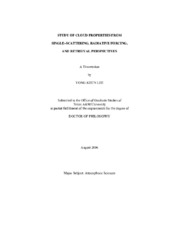| dc.contributor.advisor | Yang, Ping | |
| dc.creator | Lee, Yong-Keun | |
| dc.date.accessioned | 2010-01-15T00:15:46Z | |
| dc.date.accessioned | 2010-01-16T02:06:06Z | |
| dc.date.available | 2010-01-15T00:15:46Z | |
| dc.date.available | 2010-01-16T02:06:06Z | |
| dc.date.created | 2006-08 | |
| dc.date.issued | 2009-06-02 | |
| dc.identifier.uri | https://hdl.handle.net/1969.1/ETD-TAMU-1734 | |
| dc.description.abstract | This dissertation reports on three different yet related topics in light scattering
computation, radiative transfer simulation, and remote sensing implementation,
regarding the cloud properties and the retrieval of cloud properties from satellite-based
infrared radiometric measurements. First, the errors associated with the use of circular
cylinders as surrogates for hexagonal columns in computing the optical properties of
pristine ice crystals at infrared (8-12 µm) wavelengths are investigated. It is found that
the differences between the results for circular cylinders and hexagonal columns are on
the order of a few percent at infrared wavelengths. Second, investigated in this
dissertation are the outgoing broadband longwave and window channel radiances at the
top-of-atmosphere under clear-sky conditions on the basis of the data acquired by the
Cloud and the Earth's Radiant Energy System (CERES) instrument onboard the NASA
Terra satellite platform. Based on the comparison of the observed broadband radiances
with those obtained from rigorous radiative transfer simulations, it is found that the
theoretical results tend to be larger than their measured counterparts. Extensive sensitivity studies regarding the uncertainties of various parameters were carried out.
Within the considered uncertainties of various factors, the computed radiances are still
larger than the observed radiances if thin cirrus clouds are excluded. Thus, a potential
cause for the differences could be associated with the presence of thin cirrus clouds
whose visible optical thickness is smaller than approximately 0.3. Third, presented in
this dissertation is an illustration of the application of hyperspectral infrared channel
observations to the retrieval of the cloud properties. Specifically, the hyperspectral
measurements acquired from the Atmospheric Infrared Sounder (AIRS) aboard the
NASA Aqua platform are used to infer cloud top pressure, effective cloud amount, cloud
thermodynamic phase, cloud optical thickness, and the effective size of cloud particles.
The AIRS-based retrievals are compared with the counterparts of the operational cloud
products derived from the Moderate Resolution Imaging Spectroradiometer (MODIS).
The two retrievals agree reasonably well except for the retrieved cloud effective particle
size. Furthermore, the diurnal and seasonal contrasts of cloud properties are also
investigated on the basis of the cloud properties retrieved from the AIRS data. | en |
| dc.format.medium | electronic | en |
| dc.format.mimetype | application/pdf | |
| dc.language.iso | en_US | |
| dc.subject | hyspectral infrared channels | en |
| dc.subject | longwave and window band radiances | en |
| dc.subject | single-scattering properties | en |
| dc.title | Study of cloud properties from single-scattering, radiative forcing, and retrieval perspectives | en |
| dc.type | Book | en |
| dc.type | Thesis | en |
| thesis.degree.department | Atmospheric Sciences | en |
| thesis.degree.discipline | Atmospheric Sciences | en |
| thesis.degree.grantor | Texas A&M University | en |
| thesis.degree.name | Doctor of Philosophy | en |
| thesis.degree.level | Doctoral | en |
| dc.contributor.committeeMember | Huang, Hung-Lung | |
| dc.contributor.committeeMember | Kattawar, George | |
| dc.contributor.committeeMember | North, Gerald | |
| dc.contributor.committeeMember | Wilheit, Thomas | |
| dc.type.genre | Electronic Dissertation | en |
| dc.type.material | text | en |
| dc.format.digitalOrigin | born digital | en |


